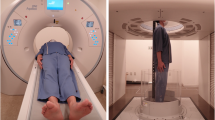Abstract
Purpose
The purpose of this study was to assess accurately the three-dimensional movements of the scapula and humerus relative to the thorax during internal/external rotation motion with abduction of the shoulder joint.
Methods
Ten right shoulders of ten healthy volunteers were examined using a wide-gantry open magnetic resonance imaging (MRI) system. MRI was performed every 30° from 90° external rotation to 90° internal rotation of the shoulder joint.
Results
The contribution ratio of the scapulothoracic joint was 12.5% about the long axis of the humerus during internal/external rotation motion. With arm position changes from 90° external rotation to 60° internal rotation, most movement was performed by the glenohumeral joint. Conversely, at internal rotation of ≥60°, the scapula began to markedly tilt in the anterior direction. At 90° internal rotation, the scapula was significantly tilted anteriorly (p < 0.05) when compared with the other positions.
Conclusions
We clarified the existence of a specific scapulohumeral motion pattern, whereby the glenohumeral joint moves with internal rotation and the scapulothoracic joint moves with anterior tilt together with internal rotation motion of the shoulder joint.





Similar content being viewed by others

References
McClure PW, Michener LA, Sennett BJ et al (2001) Direct 3-dimensional measurement of scapular kinematics during dynamic movements in vivo. J Shoulder Elbow Surg 10(3):269–277
Ludewig PM, Cook TM, Nawoczenski DA (1996) Three-dimensional scapular orientation and muscle activity at selected positions of humeral elevation. J Orthop Sports Phys Ther 24(2):57–65
van der Helm FC, Pronk GM (1995) Three-dimensional recording and description of motions of the shoulder mechanism. J Biomech Eng 117(1):27–40
McQuade KJ, Hwa Wei S, Smidt GL (1995) Effects of local muscle fatigue on three-dimensional scapulohumeral rhythm. Clin Biomech (Bristol, Avon) 10(3):144–148
Rettig O, Fradet L, Kasten P et al (2009) A new kinematic model of the upper extremity based on functional joint parameter determination for shoulder and elbow. Gait Posture 30(4):469–476
Lovern B, Stroud LA, Evans RO et al (2009) Dynamic tracking of the scapula using skin-mounted markers. Proc Inst Mech Eng H 223(7):823–831
Bourne DA, Choo AM, Regan WD et al (2007) Three-dimensional rotation of the scapula during functional movements: an in vivo study in healthy volunteers. J Shoulder Elbow Surg 16(2):150–162
Ludewig PM, Phadke V, Braman JP et al (2009) Motion of the shoulder complex during multiplanar humeral elevation. J Bone Joint Surg Am 91(2):378–389
Lorensen WE, Cline HE (1987) Marching cubes: a high resolution 3D surface construction algorithm. Comput Graph 21(4):163–170
Hill DL, Batchelor PG, Holden M et al (2001) Medical image registration. Phys Med Biol 46:R1–R45
Ishii T, Mukai Y, Hosono N et al (2004) Kinematics of the upper cervical spine in rotation: in vivo three-dimensional analysis. Spine 29(7):E139–E144
Wu G, van der Helm FC, Veeger HE et al (2005) ISB recommendation on definitions of joint coordinate systems of various joints for the reporting of human joint motion—Part II: shoulder, elbow, wrist and hand. J Biomech 38(5):981–992
Karduna AR, Williams GR, Williams JL et al (1996) Kinematics of the glenohumeral joint: influences of muscle forces, ligamentous constraints, and articular geometry. J Orthop Res 14(6):986–993
Huffman GR, Tibone JE, McGarry MH et al (2006) Path of glenohumeral articulation throughout the rotational range of motion in a thrower’s shoulder model. Am J Sports Med 34(10):1662–1669
Inman VT, Saunders JB, Abbott LC (1944) Observations of the function of the shoulder joint. J Bone Joint Surg Am 26(1):1–30
Freedman L, Munro RR (1966) Abduction of the arm in the scapular plane: scapular and glenohumeral movements. A roentgenographic study. J Bone Joint Surg Am 48(8):1503–1510
Poppen NK, Walker PS (1976) Normal and abnormal motion of the shoulder. J Bone Joint Surg Am 58(2):195–201
Paletta GA Jr, Warner JJ, Warren RF et al (1997) Shoulder kinematics with two-plane X-ray evaluation in patients with anterior instability or rotator cuff tearing. J Shoulder Elbow Surg 6(6):516–527
Bey MJ, Kline SK, Zauel R et al (2008) Measuring dynamic in-vivo glenohumeral joint kinematics: technique and preliminary results. J Biomech 41(3):711–714
Nishinaka N, Tsutsui H, Mihara K et al (2008) Determination of in vivo glenohumeral translation using fluoroscopy and shape-matching techniques. J Shoulder Elbow Surg 17(2):319–322
Boyer PJ, Massimini DF, Gill TJ et al (2008) In vivo articular cartilage contact at the glenohumeral joint: preliminary report. J Orthop Sci 13(4):359–365
Goto A, Moritomo H, Murase T et al (2004) In vivo elbow biomechanical analysis during flexion: three-dimensional motion analysis using magnetic resonance imaging. J Shoulder Elbow Surg 13(4):441–447
Moritomo H, Murase T, Goto A et al (2006) In vivo three-dimensional kinematics of the midcarpal joint of the wrist. J Bone Joint Surg Am 88(3):611–621
Sahara W, Sugamoto K, Murai M et al (2006) 3D kinematic analysis of the acromioclavicular joint during arm abduction using vertically open MRI. J Orthop Res 24(9):1823–1831
Sahara W, Sugamoto K, Murai M et al (2007) Three-dimensional clavicular and acromioclavicular rotations during arm abduction using vertically open MRI. J Orthop Res 25(9):1243–1249
Acknowledgments
We wish to thank Mr. Y. Sakaguchi, a radiological technologist, for performing MRI at Matsumoto medical clinic and Mr. R. Nakao, a programmer, for developing the software.
Author information
Authors and Affiliations
Corresponding author
Electronic supplementary materials
Below is the link to the electronic supplementary material.
(MPEG 2373 kb)
Rights and permissions
About this article
Cite this article
Koishi, H., Goto, A., Tanaka, M. et al. In vivo three-dimensional motion analysis of the shoulder joint during internal and external rotation. International Orthopaedics (SICOT) 35, 1503–1509 (2011). https://doi.org/10.1007/s00264-011-1219-5
Received:
Accepted:
Published:
Issue Date:
DOI: https://doi.org/10.1007/s00264-011-1219-5



